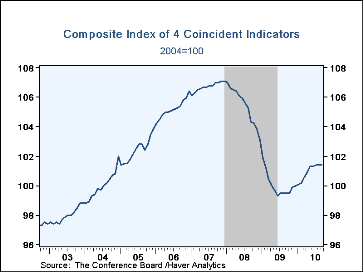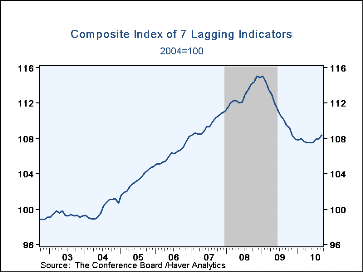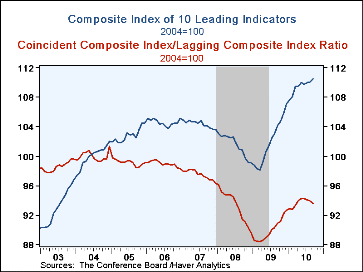 Global| Oct 21 2010
Global| Oct 21 2010U.S. Leading Economic Indicators Rise To New High
by:Tom Moeller
|in:Economy in Brief
Summary
The Conference Board reported that its Index of Leading Economic Indicators rose 0.3% during September after a downwardly revised 0.1% August uptick that was initially reported at 0.3%. Nevertheless, the latest reading was a record [...]
 The Conference Board reported that its Index of Leading Economic
Indicators rose 0.3% during September after a downwardly revised 0.1%
August uptick that was initially reported at 0.3%. Nevertheless, the
latest reading was a record high. Despite these gains, the three-month
rate of increase improved just slightly to 2.4% (AR). Still, that was
nearly its weakest since March of last year when it was declining. Early
this year the index was rising at a double-digit rate. The leading index
is based on actual reports for eight economic data series. The Conference
Board initially estimates two series, consumer and capital goods orders.
The Conference Board reported that its Index of Leading Economic
Indicators rose 0.3% during September after a downwardly revised 0.1%
August uptick that was initially reported at 0.3%. Nevertheless, the
latest reading was a record high. Despite these gains, the three-month
rate of increase improved just slightly to 2.4% (AR). Still, that was
nearly its weakest since March of last year when it was declining. Early
this year the index was rising at a double-digit rate. The leading index
is based on actual reports for eight economic data series. The Conference
Board initially estimates two series, consumer and capital goods orders.
The breadth of increase amongst the component leading series slipped to just 55%. Lower initial jobless insurance claims, higher stock prices, a widened yield spread between 10-year Treasuries & Fed funds as well as a higher real money supply each contributed positively. Vendor performance and building permits fell. Other series were unchanged.
The index of coincident indicators was unchanged for the third month in the last four. Moreover, the three-month change of 0.4% remained its weakest since October of last year. Only two of the four component series ticked up last month including real personal income and business sales. Industrial production declined while payroll employment fell with the decline in the number of Census workers.
The lagging index rose for the third consecutive month as C&I loans increased. The ratio of coincident-to-lagging indicators (another leading indicator) fell for the third consecutive month.
The Conference Board figures are available in Haver's BCI database. Visit the Conference Board's site for coverage of leading indicator series from around the world.
| Business Cycle Indicators(%) | September | August | July | 3 Month %Chg.(AR) |
2009 | 2008 | 2007 |
|---|---|---|---|---|---|---|---|
| Leading | 0.3 | 0.1 | 0.2 | 2.2 | 0.5 | -2.7 | -0.2 |
| Coincident | 0.0 | 0.0 | 0.1 | 0.4 | -5.1 | -1.2 | 1.4 |
| Lagging | 0.4 | 0.1 | 0.4 | 3.6 | -1.6 | 3.2 | 3.0 |
Tom Moeller
AuthorMore in Author Profile »Prior to joining Haver Analytics in 2000, Mr. Moeller worked as the Economist at Chancellor Capital Management from 1985 to 1999. There, he developed comprehensive economic forecasts and interpreted economic data for equity and fixed income portfolio managers. Also at Chancellor, Mr. Moeller worked as an equity analyst and was responsible for researching and rating companies in the economically sensitive automobile and housing industries for investment in Chancellor’s equity portfolio. Prior to joining Chancellor, Mr. Moeller was an Economist at Citibank from 1979 to 1984. He also analyzed pricing behavior in the metals industry for the Council on Wage and Price Stability in Washington, D.C. In 1999, Mr. Moeller received the award for most accurate forecast from the Forecasters' Club of New York. From 1990 to 1992 he was President of the New York Association for Business Economists. Mr. Moeller earned an M.B.A. in Finance from Fordham University, where he graduated in 1987. He holds a Bachelor of Arts in Economics from George Washington University.








